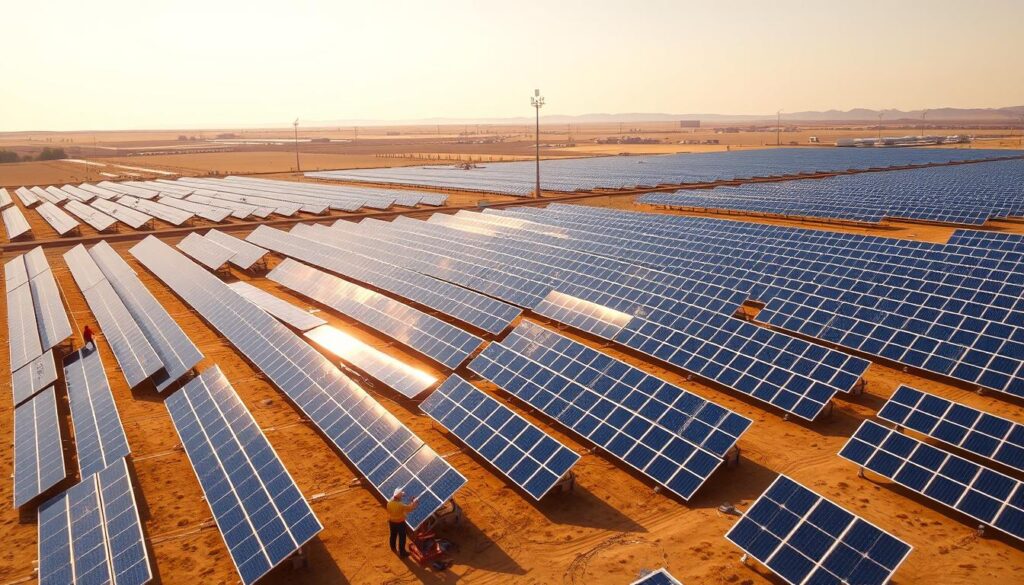As the world shifts towards renewable energy design, the demand for efficient and sustainable solar farms has never been higher. But, what makes a solar farm truly effective? The answer lies in meticulous planning and execution, involving various disciplines such as solar farm engineering.
Building a solar farm requires a comprehensive approach, from determining the system size and layout to selecting the right equipment and ensuring compliance with engineering standards. It’s a complex process that involves not just the installation of solar panels, but also a thorough understanding of electrical design and interconnection details. For a detailed guide on the basics of solar plant design, you can refer to resources like solar plant design guide.
Key Takeaways
- Understanding the importance of solar farm engineering in renewable energy projects.
- The need for comprehensive planning and execution in building a solar farm.
- Key elements involved in solar farm design, including system size and layout.
- The role of electrical design and interconnection in solar farm engineering.
- Ensuring compliance with relevant engineering standards and codes.
Understanding Solar Farm Engineering
As the world shifts towards cleaner energy, solar farm engineering plays a vital role. Solar farms are extensive areas filled with photovoltaic panels that capture the sun’s energy to supply electricity for homes, businesses, and communities.
Definition and Significance
Solar farm engineering involves the design, development, and implementation of solar energy projects. It encompasses photovoltaic system planning, ensuring that solar farms are efficient and productive. The significance of solar farm engineering lies in its contribution to sustainable solar solutions, reducing our reliance on fossil fuels and mitigating climate change.
Effective solar farm engineering requires careful planning, from site selection to grid connection. It involves assessing the solar resource, designing the layout, and ensuring compliance with regulatory requirements.
Role in Renewable Energy Landscape
Solar farm engineering is crucial in the renewable energy landscape, enabling the transition to cleaner energy sources. By harnessing solar energy, we can reduce greenhouse gas emissions and promote energy sustainability. For more information on sustainable engineering solutions, visit World Civil Society.
The role of solar farm engineering extends beyond energy production; it also involves community engagement and ensuring that projects are socially and environmentally responsible.
Types of Solar Farms
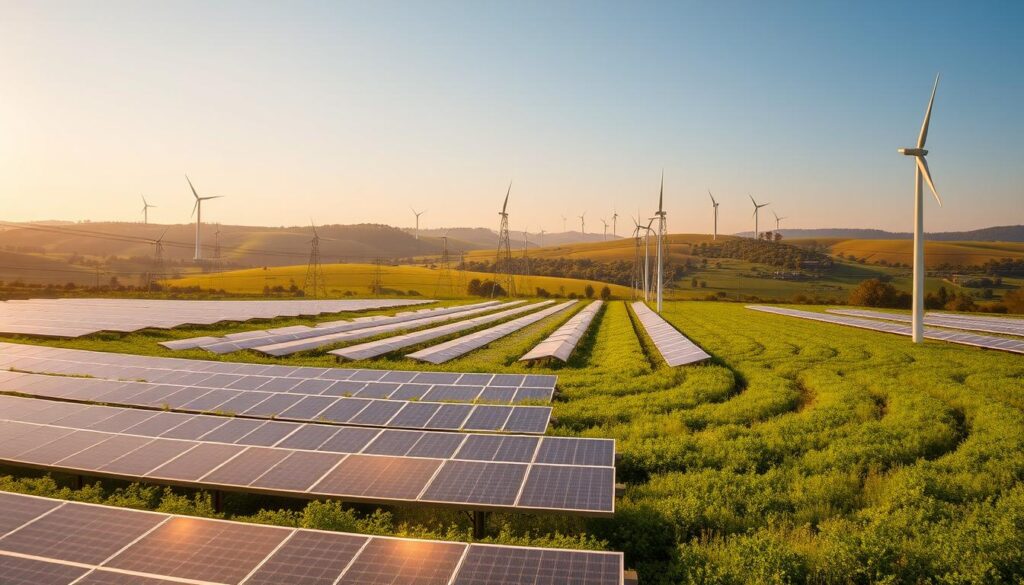
The solar farm landscape is diverse, featuring utility-scale, community, and rooftop installations. These different types of solar farms play a crucial role in developing green energy infrastructure, catering to various energy needs and contributing to a sustainable future.
Utility-Scale Solar Farms
Utility-scale solar farms are large installations that generate electricity on a massive scale, often spanning hundreds of acres. These solar farms are typically connected to the grid and supply power to utilities, which then distribute it to homes and businesses. According to industry experts, “utility-scale solar is becoming increasingly cost-competitive with fossil fuels, making it a viable option for large-scale energy production.”
Community Solar Projects
Community solar projects are designed for communities or organizations that want to invest in solar energy without installing panels on their property. These projects allow multiple individuals or entities to share the benefits of a single solar array, making renewable energy more accessible. As noted by a renewable energy advocate, “community solar programs democratize access to clean energy, enabling more people to participate in the transition to a sustainable energy future.”
Rooftop Solar Installations
Rooftop solar installations involve mounting solar panels on residential or commercial buildings, providing a decentralized source of renewable energy. These installations are ideal for property owners who want to reduce their energy bills and carbon footprint. With advancements in technology, rooftop solar has become more efficient and affordable, making it an attractive option for those looking to embrace sustainable energy solutions.
In conclusion, the various types of solar farms—utility-scale, community, and rooftop—each have unique characteristics and advantages, contributing significantly to the development of green energy infrastructure. As the world continues to transition towards renewable energy sources, understanding these different types of solar farms is essential for stakeholders across the energy sector.
Site Selection Criteria
Site selection is a foundational step in solar farm development, influencing its overall performance and viability. The process involves evaluating several critical factors to ensure the solar farm operates efficiently and effectively.
Geographic Considerations
Geographic considerations play a pivotal role in determining the suitability of a site for a solar farm. Factors such as latitude, climate, and topography are crucial. Latitude affects the amount of solar irradiance a location receives, while climate influences the overall energy production potential. Topography, including the slope and orientation of the land, impacts the feasibility of installing solar panels.
Latitude and Solar Irradiance: Locations closer to the equator receive more consistent and higher levels of solar irradiance, making them ideal for solar farms. However, other regions can also be suitable with the right technology and design.
Land Use Regulations
Land use regulations are another critical aspect of site selection. These regulations vary by jurisdiction and can significantly impact the feasibility of a solar farm project. Compliance with local zoning laws, environmental regulations, and obtaining necessary permits are essential steps in the site selection process.
- Zoning laws dictate how land can be used, potentially restricting solar farm development in certain areas.
- Environmental regulations may require assessments to ensure that the solar farm does not harm local ecosystems.
Proximity to Power Lines
The proximity of a solar farm to existing power lines and transmission infrastructure is a significant factor in site selection. Being close to power lines can reduce the cost and complexity of connecting the solar farm to the grid, thereby enhancing its economic viability.
| Factor | Importance | Impact on Solar Farm |
|---|---|---|
| Latitude | High | Affects solar irradiance and energy production |
| Land Use Regulations | High | Determines feasibility and compliance requirements |
| Proximity to Power Lines | High | Influences connection costs and grid integration |
In conclusion, careful consideration of geographic factors, land use regulations, and proximity to power lines is essential for the successful development of a solar farm. By evaluating these site selection criteria, developers can ensure the long-term viability and efficiency of their solar panel installation services.
Solar Technology Options
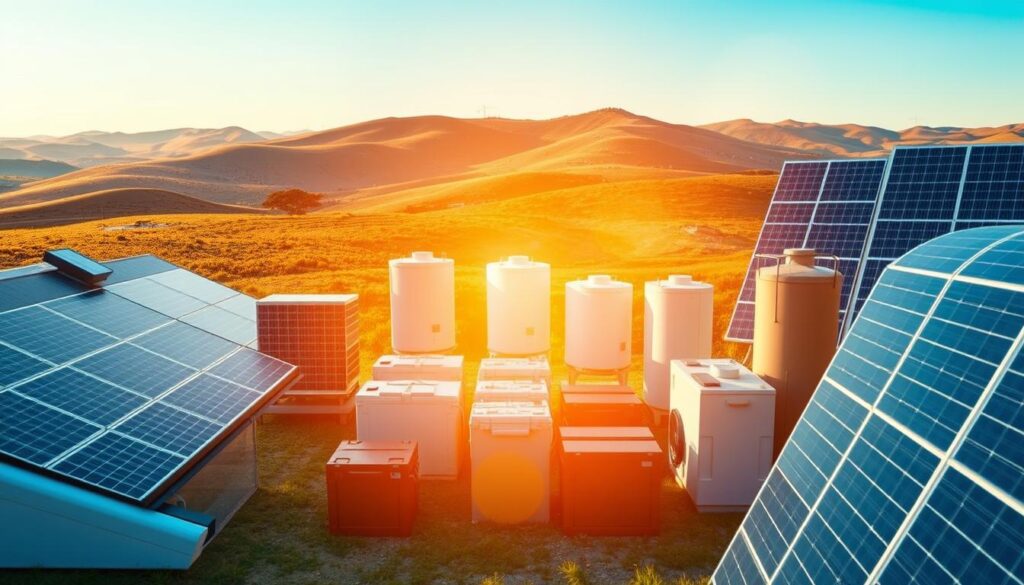
Understanding the different solar technology options is essential for effective solar farm design. The design process involves selecting the right type of solar technology, such as traditional photovoltaic panels or concentrated solar power systems, to ensure optimal energy production and efficiency in solar energy project management.
Photovoltaic (PV) Systems
Photovoltaic (PV) systems are one of the most common solar technologies used in solar farms. They convert sunlight directly into electricity using semiconducting materials. PV systems are known for their modularity and scalability, making them suitable for a wide range of solar energy projects.
Advantages of PV Systems:
- Modular design allows for easy expansion
- Low maintenance requirements
- Ability to be installed on varied terrain
Concentrated Solar Power (CSP)
Concentrated Solar Power (CSP) systems use mirrors or lenses to focus sunlight onto a central tower or receiver, generating heat that is then used to produce steam and drive turbines. CSP systems are particularly effective in regions with high direct normal irradiance.
Benefits of CSP Systems:
- High efficiency in suitable climates
- Ability to store thermal energy for later use
- Scalable to large sizes
Emerging Technologies
Emerging solar technologies include innovations such as bifacial PV panels, perovskite solar cells, and solar power inverters with advanced functionalities. These technologies promise to enhance efficiency, reduce costs, and improve the overall viability of solar energy projects.
| Technology | Description | Potential Benefits |
|---|---|---|
| Bifacial PV Panels | Panels that capture sunlight on both sides | Increased energy yield |
| Perovskite Solar Cells | New type of solar cell material | Higher efficiency, lower production costs |
| Advanced Inverters | Inverters with smart grid capabilities | Enhanced grid stability, improved monitoring |
In conclusion, the choice of solar technology is a critical aspect of solar energy project management. By understanding the different options available, including PV systems, CSP, and emerging technologies, developers can make informed decisions to optimize their solar farm designs.
Design Considerations
Clean energy development through solar farms requires meticulous design considerations to optimize energy production. The layout and configuration of solar panels significantly impact the overall efficiency and output of the farm.
Layout and Spacing
The layout and spacing of solar panels are critical factors that influence the energy output of a solar farm. Proper spacing ensures that panels do not shade each other, thereby maximizing energy production. For instance, a study on solar farm design highlights the importance of optimizing layout and spacing to improve overall efficiency.
The tilt angle and orientation of solar panels also play a crucial role in determining the amount of solar irradiance captured. An optimal tilt angle can significantly enhance energy production, especially during winter months when the sun is lower in the sky.
| Design Factor | Impact on Energy Production | Considerations |
|---|---|---|
| Panel Spacing | Reduces shading, increases energy output | Dependent on latitude and panel height |
| Tilt Angle | Optimizes solar irradiance capture | Adjusted based on seasonal sun position |
| Array Configuration | Influences overall farm efficiency | Considered alongside land availability |
Energy Production Forecasting
Accurate energy production forecasting is essential for the financial viability of solar farms. It involves analyzing historical weather data, solar irradiance patterns, and other factors to predict future energy output. Advanced forecasting tools and techniques can help reduce uncertainty and improve the bankability of solar projects.
For example, using machine learning algorithms to analyze weather patterns can enhance the accuracy of energy production forecasts. This, in turn, can help investors and operators make more informed decisions regarding solar farm management.
Environmental Impact Assessments
Conducting thorough environmental impact assessments is crucial for identifying potential risks associated with solar farm development. These assessments consider factors such as habitat disruption, water usage, and visual impact on the surrounding landscape.
By understanding these environmental impacts, developers can implement measures to mitigate adverse effects. For instance, incorporating native vegetation around solar panels can help preserve local biodiversity.
In conclusion, the design of solar farms is a complex process that involves balancing energy production needs with environmental considerations. By carefully planning layout and spacing, forecasting energy production, and assessing environmental impacts, developers can create more efficient and sustainable solar farms that contribute to clean energy development.
Planning and Permitting Processes
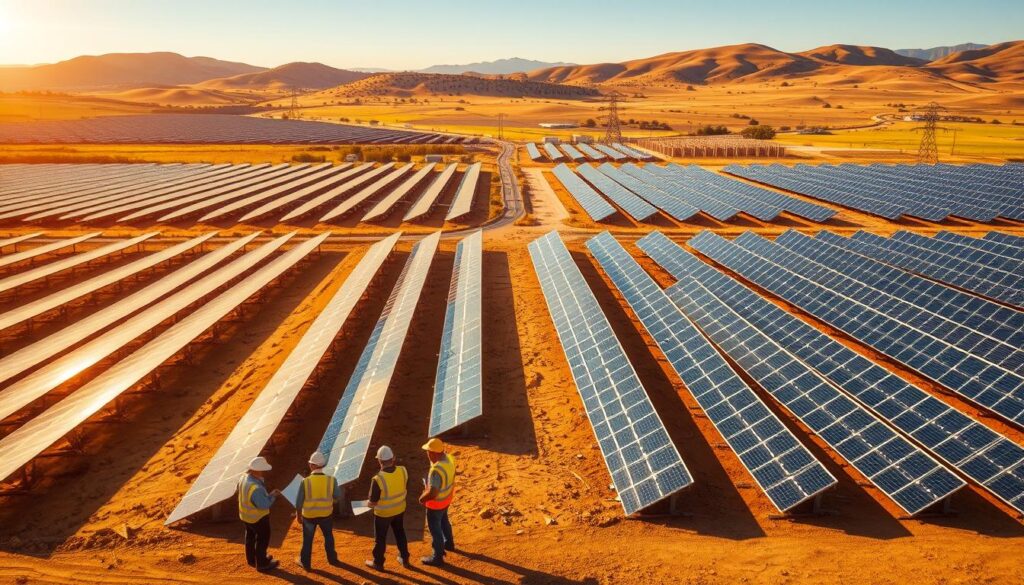
Ensuring compliance with federal, state, and local regulations is essential for the eco-friendly power generation that solar farms promise. The planning and permitting process is a critical phase in solar farm development, requiring a deep understanding of regulatory frameworks.
Federal Regulations
Federal regulations play a significant role in shaping the solar farm industry. Compliance with these regulations is crucial for ensuring that solar farms are developed in a manner that is consistent with national energy policies and environmental standards. Key federal regulations include those related to environmental impact assessments and the protection of wildlife habitats.
State and Local Permits
In addition to federal regulations, solar farm developers must also obtain state and local permits. These permits can vary significantly depending on the location of the solar farm, with different states and localities having their own set of requirements and regulations. Understanding these requirements is vital for ensuring that the solar farm is compliant with all relevant laws and regulations.
Environmental Approvals
Environmental approvals are a critical component of the permitting process for solar farms. These approvals are designed to ensure that solar farms are developed in a way that minimizes their environmental impact. This includes assessments of potential impacts on local ecosystems, water resources, and cultural heritage sites. By obtaining the necessary environmental approvals, solar farm developers can demonstrate their commitment to uroboros renewable energy design principles.
The complexity of the planning and permitting process underscores the need for careful planning and coordination among various stakeholders. By understanding and complying with the relevant regulations, solar farm developers can help ensure the success of their projects.
Financial Aspects of Solar Farms
Understanding the financial aspects of solar farms is essential for stakeholders and investors. The development of a solar farm involves significant upfront costs, ongoing expenses, and potential revenue streams.
Cost Analysis
The cost of building a solar power plant can vary widely depending on numerous factors, such as the size and capacity of the plant, the location, and the technology chosen. A detailed cost analysis is crucial to understanding the financial viability of a solar farm project.
Key components of the cost analysis include:
- Land acquisition and preparation costs
- Cost of solar panels and other equipment
- Labor costs for installation
- Permitting and regulatory compliance expenses
| Cost Component | Estimated Cost |
|---|---|
| Land Acquisition | $100,000 |
| Solar Panels | $500,000 |
| Installation Labor | $200,000 |
Funding Opportunities
Solar farm projects can be financed through various means, including project finance, equity investment, and debt financing. Understanding these funding opportunities is vital for securing the necessary capital.
“Project finance is a key financing mechanism for solar projects, allowing developers to leverage debt and equity to fund project development.”
Return on Investment (ROI)
The ROI for solar farms is influenced by factors such as energy production levels, electricity prices, and operational costs. A thorough analysis of these factors helps investors understand the potential return on their investment.
By carefully evaluating the financial aspects of solar farms, including cost analysis, funding opportunities, and ROI, stakeholders can make informed decisions about their investments in sustainable solar solutions.
Construction Phases of Solar Farms
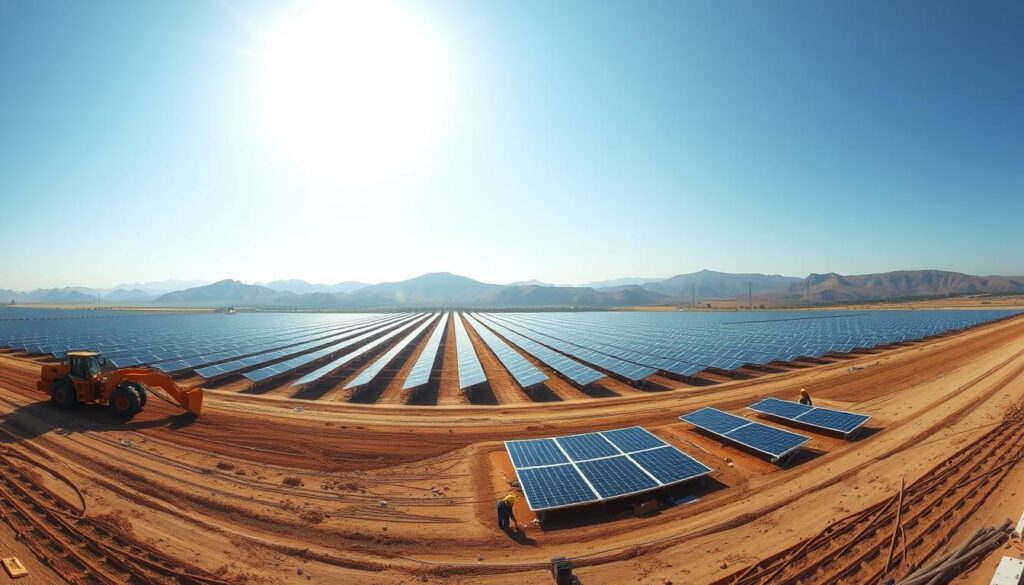
Solar farm construction is a multi-faceted process that demands careful planning and precise execution. The successful completion of a solar farm project hinges on several critical phases, from initial planning to the final installation of equipment.
Pre-Construction Planning
Pre-construction planning is a vital phase that involves site assessment, feasibility studies, and obtaining necessary permits. This stage is crucial for identifying potential challenges and developing strategies to mitigate them. Effective planning ensures that the project is executed within the defined timeline and budget.
According to industry experts, “Proper planning is the backbone of any successful solar farm construction project.”
“The pre-construction phase sets the stage for the entire project, influencing its overall success and profitability.”
Equipment Procurement
Equipment procurement is another critical phase that involves sourcing high-quality solar panels, inverters, and other necessary components. The procurement process should be guided by considerations of quality, cost, and lead time. Sourcing equipment from reputable manufacturers is essential for ensuring the reliability and performance of the solar farm.
For more detailed insights into the solar project development process, visit this resource for comprehensive guidance.
Site Preparation and Installation
Site preparation involves clearing the land, grading, and preparing the terrain for the installation of solar panels. The installation phase includes the mounting of solar panels, installation of inverters, and connection to the grid. Precision in installation is crucial for maximizing energy production and ensuring the longevity of the solar farm.
The construction phases of a solar farm are intricate and demand meticulous attention to detail. By focusing on thorough planning, quality equipment procurement, and precise installation, developers can ensure the success of their solar farm projects, contributing to the growth of green energy infrastructure.
Operation and Maintenance (O&M)
Operation and maintenance (O&M) play a vital role in ensuring solar farms operate at maximum efficiency. Effective O&M strategies are crucial for maintaining the longevity and performance of solar energy systems.
Routine Maintenance Tasks
Regular maintenance is essential for the smooth operation of solar farms. This includes cleaning solar panels to ensure maximum energy absorption, inspecting equipment for wear and tear, and performing repairs as needed. For instance, effective O&M practices can significantly enhance the overall performance of solar panel installation services.
Performance Monitoring
Continuous performance monitoring is vital for identifying potential issues before they become major problems. This involves tracking energy production levels, monitoring system health, and analyzing data to optimize performance. Advanced solar energy project management tools can help in predicting and preventing downtime, thereby maximizing energy output.
Troubleshooting Common Issues
Despite regular maintenance, issues can still arise. Common problems include faulty inverters, damaged panels, and issues with mounting structures. Having a robust troubleshooting plan in place is essential for quickly identifying and resolving these issues. This not only minimizes downtime but also ensures that the solar farm continues to operate efficiently.
| Maintenance Task | Frequency | Importance |
|---|---|---|
| Cleaning Solar Panels | Quarterly | High |
| Inspecting Equipment | Bi-Annually | High |
| Software Updates | As Needed | Medium |
Interconnection with the Grid
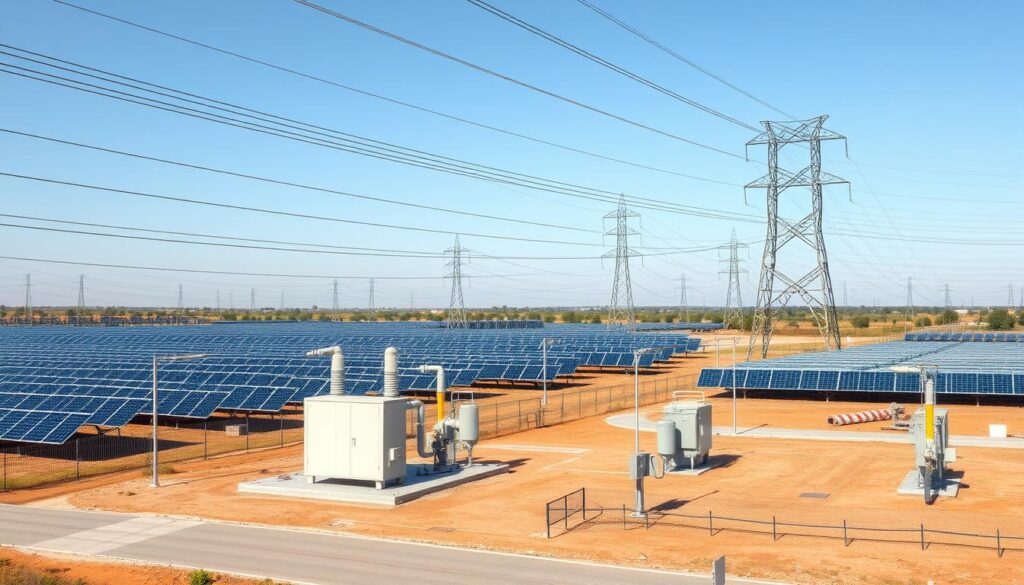
As the world shifts towards cleaner energy sources, understanding how to connect solar farms to the grid becomes increasingly important. This process is crucial for the successful integration of solar energy into our power systems, enabling clean energy development and eco-friendly power generation.
Understanding Grid Requirements
Grid requirements are a set of technical and operational standards that solar farms must meet to connect to the electrical grid. These requirements ensure that the solar farm can operate safely and efficiently in conjunction with the existing power infrastructure. Key aspects include voltage levels, frequency regulation, and grid stability.
- Voltage compatibility to ensure seamless integration
- Frequency regulation to maintain grid stability
- Power quality to meet the grid’s operational standards
For a detailed understanding of grid requirements and how they impact solar farm operations, it’s essential to consult with grid operators and relevant technical guidelines.
Connection Agreements
Securing a connection agreement is a critical step in the process of connecting a solar farm to the grid. This agreement outlines the terms and conditions under which the solar farm will be connected and operated in relation to the grid. It covers aspects such as metering, data exchange, and operational responsibilities.
To learn more about the process of connecting solar farms to the grid, visit https://selectrow.com/solar-farm-connect-to-the-grid/ for comprehensive insights and guidelines.
Compliance with Regulations
Compliance with regulatory requirements is vital for the successful connection and operation of solar farms. This involves adhering to local, state, and federal regulations regarding grid connection, environmental impact, and safety standards.
- Obtain necessary permits and approvals from regulatory bodies
- Conduct environmental impact assessments as required
- Ensure compliance with safety and technical standards
By understanding grid requirements, securing appropriate connection agreements, and ensuring compliance with regulations, solar farm developers can facilitate a smooth and efficient connection to the grid, thereby supporting the broader adoption of renewable energy sources.
Community Engagement and Outreach
Community engagement and outreach are key components in the planning and execution of solar farms. As the world shifts towards renewable energy design and sustainable solar solutions, understanding the needs and concerns of local communities becomes increasingly important.
Stakeholder Communication
Effective stakeholder communication is the backbone of successful community engagement. It involves not just informing the community about the solar farm project, but also listening to their concerns and incorporating their feedback into the project design. This two-way communication helps in building trust and ensures that the project is aligned with the community’s values and expectations.
Some key aspects of stakeholder communication include:
- Regular updates on the project’s progress
- Public meetings and hearings
- Collaboration with local leaders and organizations
Hosting Informational Sessions
Hosting informational sessions is a crucial step in the community outreach process. These sessions provide an opportunity for the community to learn about the project, ask questions, and express their concerns. It’s essential to make these sessions accessible and informative, using clear language and visual aids to help the community understand the project’s details.
For example, a community engagement plan might include:
- Initial public meeting to introduce the project
- Follow-up sessions to provide updates and gather feedback
- Final meeting to discuss the project’s approval and next steps
A successful example of community engagement can be seen in the Rich Road Solar Energy Center Community Engagement, which outlines a comprehensive approach to stakeholder communication and public outreach.
Addressing Public Concerns
Addressing public concerns is a critical aspect of community engagement. This involves not just responding to questions and complaints, but also proactively addressing potential issues before they become major concerns. By doing so, developers can mitigate opposition and build a stronger, more supportive community.
Common concerns related to solar farms include their impact on local wildlife, visual aesthetics, and property values. By providing clear, factual information and demonstrating a commitment to sustainable solar solutions, developers can alleviate these concerns and foster a more positive reception of the project.
Future Trends in Solar Farm Engineering
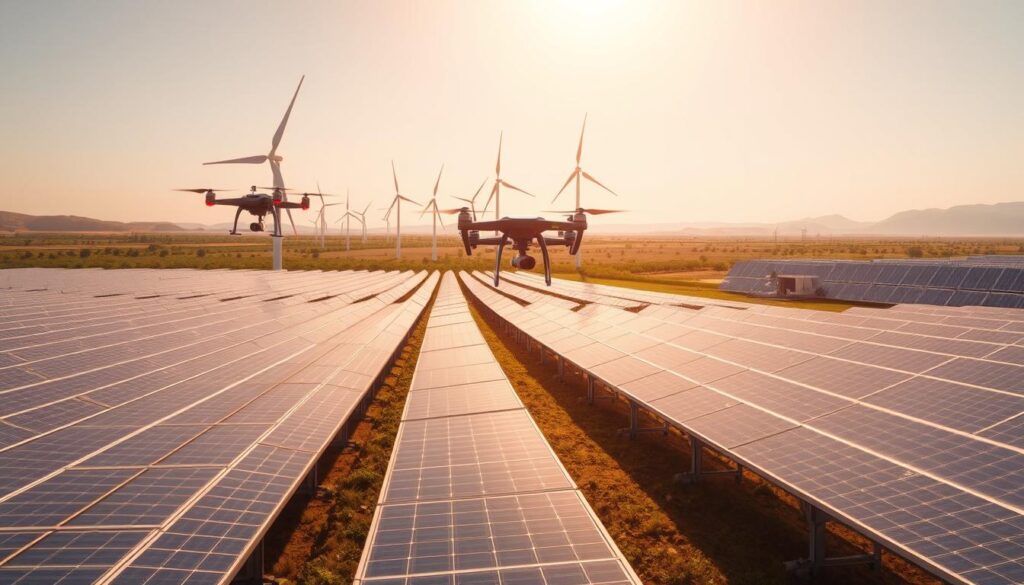
The future of solar farm engineering is being shaped by advancements in technology, changes in policy and regulations, and the impact of climate change. As the world continues to transition towards renewable energy sources, understanding these trends is crucial for stakeholders in the solar industry.
Technological Advancements
Technological innovations are at the forefront of the evolution in solar farm engineering. Improvements in photovoltaic system planning are enhancing the efficiency and output of solar farms. Some key advancements include:
- Bifacial solar panels that can generate electricity from both sides
- Advanced tracking systems that optimize energy production
- Energy storage solutions that improve grid stability
These technologies are not only increasing the viability of solar farms but also reducing costs and environmental impacts.
Policy and Regulatory Changes
Policy and regulatory frameworks play a significant role in shaping the future of solar farm engineering. Governments around the world are implementing policies to support the development of green energy infrastructure. Some key areas of focus include:
| Policy Area | Description | Impact |
|---|---|---|
| Renewable Portfolio Standards | Require utilities to generate a certain percentage of electricity from renewable sources | Increases demand for solar energy |
| Tax Incentives | Offer financial incentives for solar farm development | Reduces upfront costs for developers |
| Grid Connection Policies | Regulate how solar farms connect to the grid | Ensures grid stability and reliability |
Impact of Climate Change on Engineering
Climate change is having a profound impact on solar farm engineering. Rising temperatures and extreme weather events are forcing engineers to adapt their designs and practices. Some considerations include:
- Designing solar farms to withstand extreme weather conditions
- Using materials and coatings that can resist degradation from increased UV exposure
- Incorporating climate resilience into project planning and execution
By understanding and addressing these challenges, the solar industry can continue to grow and contribute to a sustainable energy future.
Conclusion: Keys to Successful Solar Farm Engineering
Successful solar farm engineering requires careful consideration of various factors, including site selection, technology options, design considerations, and regulatory compliance. Effective solar energy project management is crucial to ensure that these factors are integrated seamlessly.
Key Considerations for Solar Farm Engineering
Recapping the essential factors, it’s clear that site selection, solar technology options, and design considerations play a critical role in determining the viability of a solar farm. Ensuring compliance with regulatory requirements is also vital.
Future of Solar Energy Projects
As the world shifts towards renewable energy, the importance of solar farm engineering will continue to grow. By understanding the complexities involved in solar energy project management, developers can better navigate the challenges and capitalize on the opportunities.
With careful planning and execution, solar farm engineering can contribute significantly to a sustainable energy future. As technology continues to evolve, we can expect to see more efficient and effective solar energy projects.
